The matchup between Sheffield United and Arsenal saw Arsenal carry their lackluster away form to Bramall Lane. Sheffield United came away with the 1-0 home win on the excellently executed set-piece goal by Lys Mousset. Arsenal’s poor result brought them to only 1 win in 5 matches away from home.
This tactical analysis will breakdown three key aspects impacting the match. The first aspect is Chris Wilder sent out Sheffield United with a clear attacking tactic to unbalance Arsenal. Next, a breakdown of Wilder’s intentional plan to exploit Unai Emery’s defensive corner setup. Finally, Arsenal had non-dominating domination of possession.
Lineups
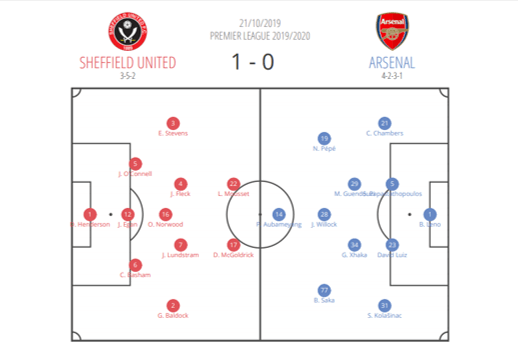
Sheffield United lined up in a 3-5-2 formation to begin the match. Dean Henderson in goal behind the three centre backs Jack O’Connell, John Egan, and Chris Basham. Enda Stevens and George Baldock provided width in midfield with John Fleck, Oliver Norwood, and John Lundstram manning the centre. Goalscorer Lys Mousset and David McGoldrick comprised the forward line.
Arsenal countered with a 4-2-3-1 setup. Bernd Leno in goal with a back four of Calum Chambers, Sokratis, David Luiz, and Sead Kolašinac. Granit Xhaka and Mattéo Guendouzi sat in front of the back four. Joseph Willock was in the middle attacking role flanked by Bukayo Saka and Nicolas Pépé. Pierre-Emerick Aubameyang was the striker.
Sheffield United Target the Left Side
Chris Wilder had a clear intention to attack down the left side of the pitch against Arsenal. The following graphic shows how committed Sheffield United was to the tactic. According to WhoScored.com, 56% of the Sheffield United attacks were down the left side. That is a stunningly high amount signalling a clear tactical strategy.
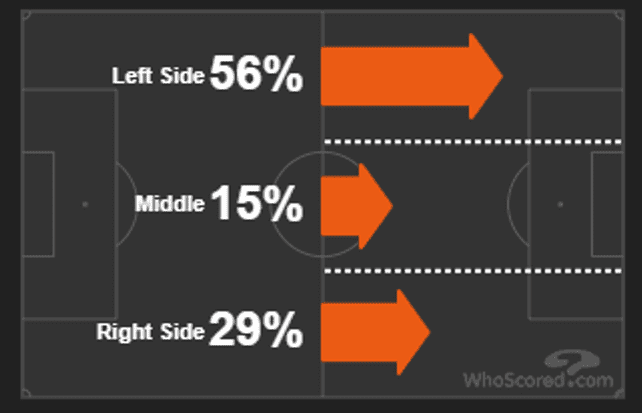
Build Up down the Left Side
Here we see Sheffield United exploit the left side of the pitch in a sustained attack. The first image shows #3, Stevens, on the ball with McGoldrick square. Chambers and Guendouzi are drawn forward onto Stevens and McGoldrick. John Fleck moves between the lines behind Guendouzi creating the numerical overload.
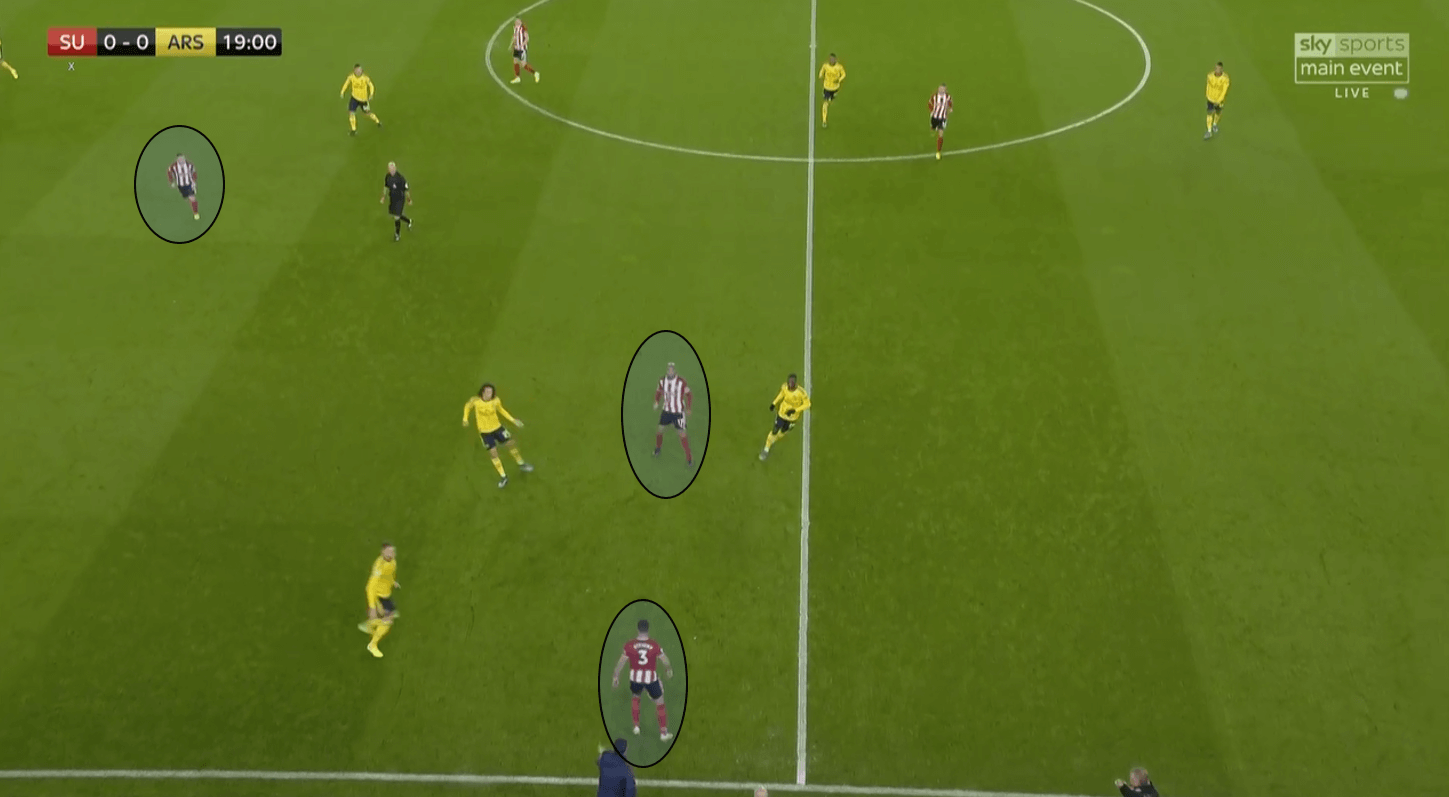
Stevens plays the square ball giving McGoldrick the option to play the ball forward to Fleck between the lines. Guendouzi closes down aggressively preventing the forward pass. McGoldrick is forced back to O’Connell instead.
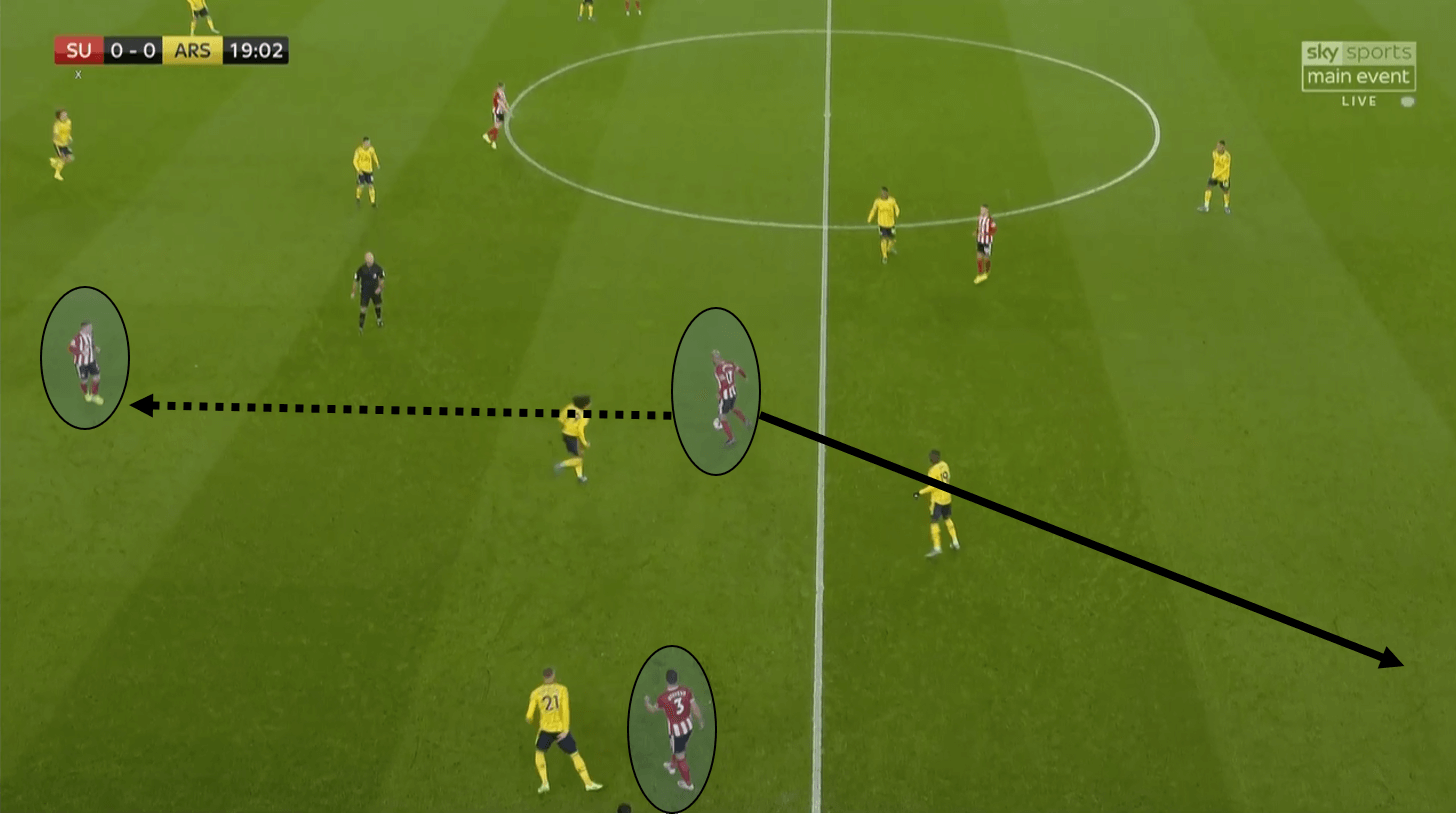
O’Connell plays the ball forward into the centre forward exploiting the left side overload.
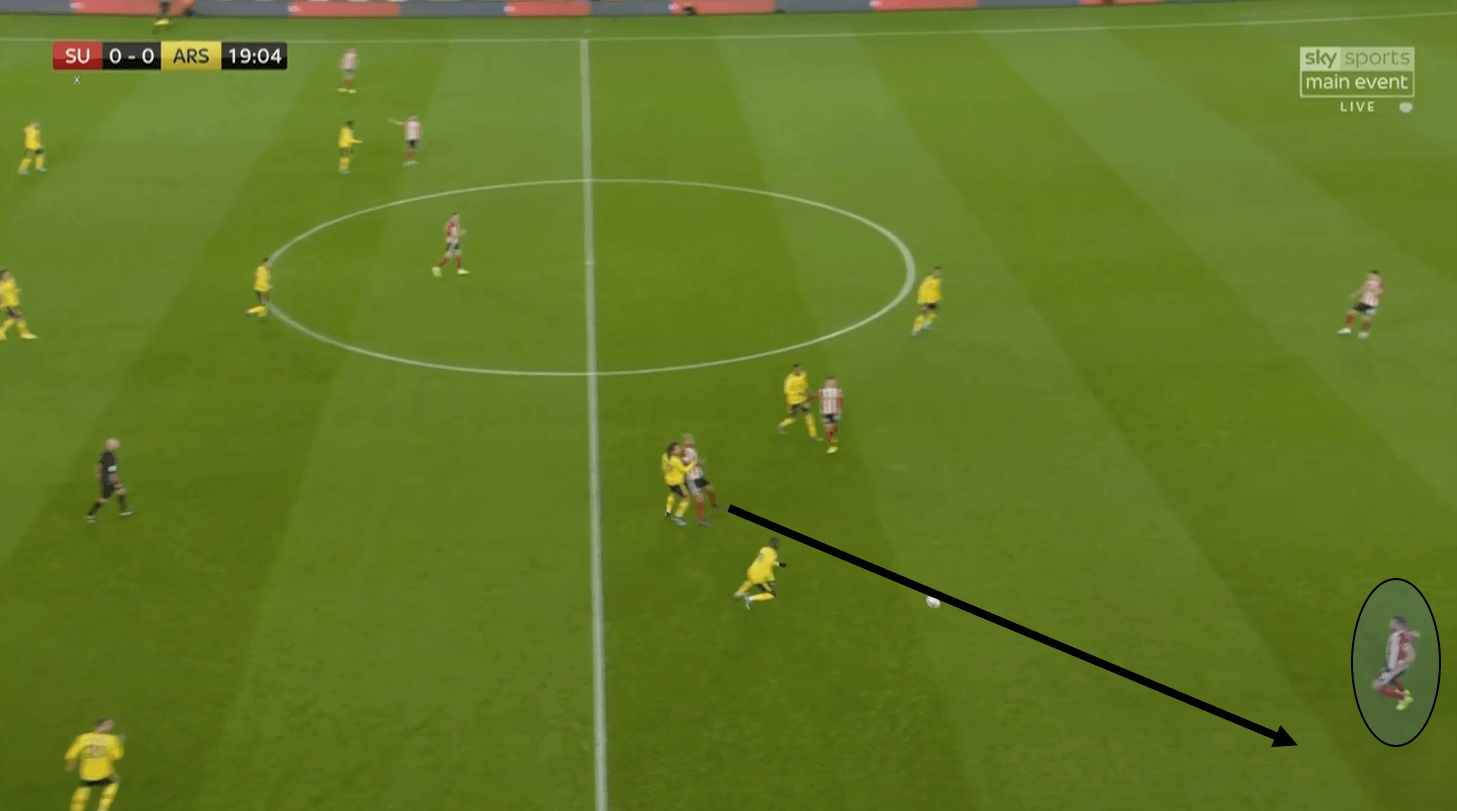
O’Connell plays an excellent splitting pass forward that gets the isolation of the Sheffield United forward with Luiz with McGoldrick and Fleck in behind Guendouzi and Chambers. The result is a three vs two for Sheffield United.
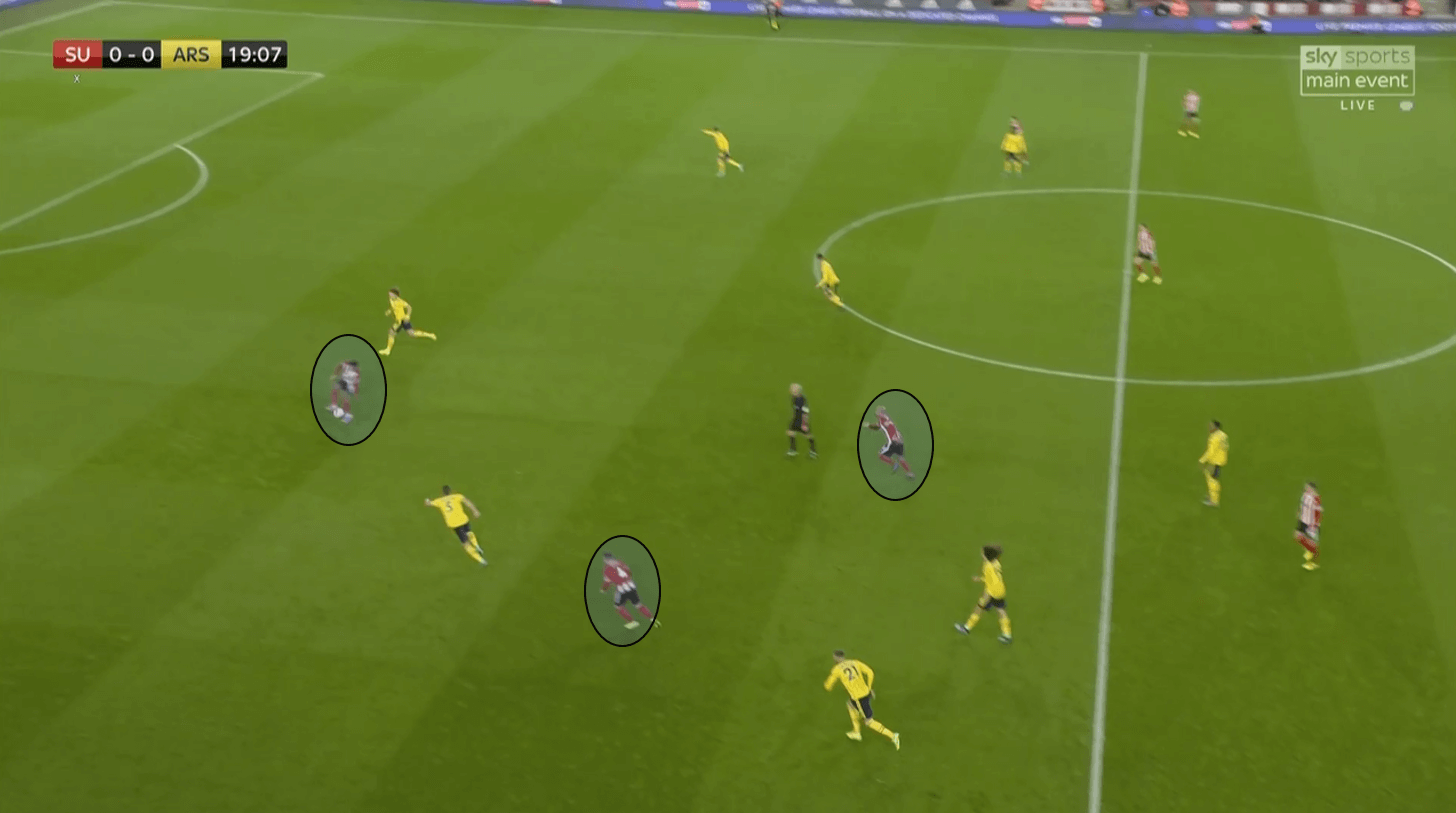
McGoldrick works forward and plays Fleck into the channel. The key is drawing the Arsenal defender before releasing the ball.
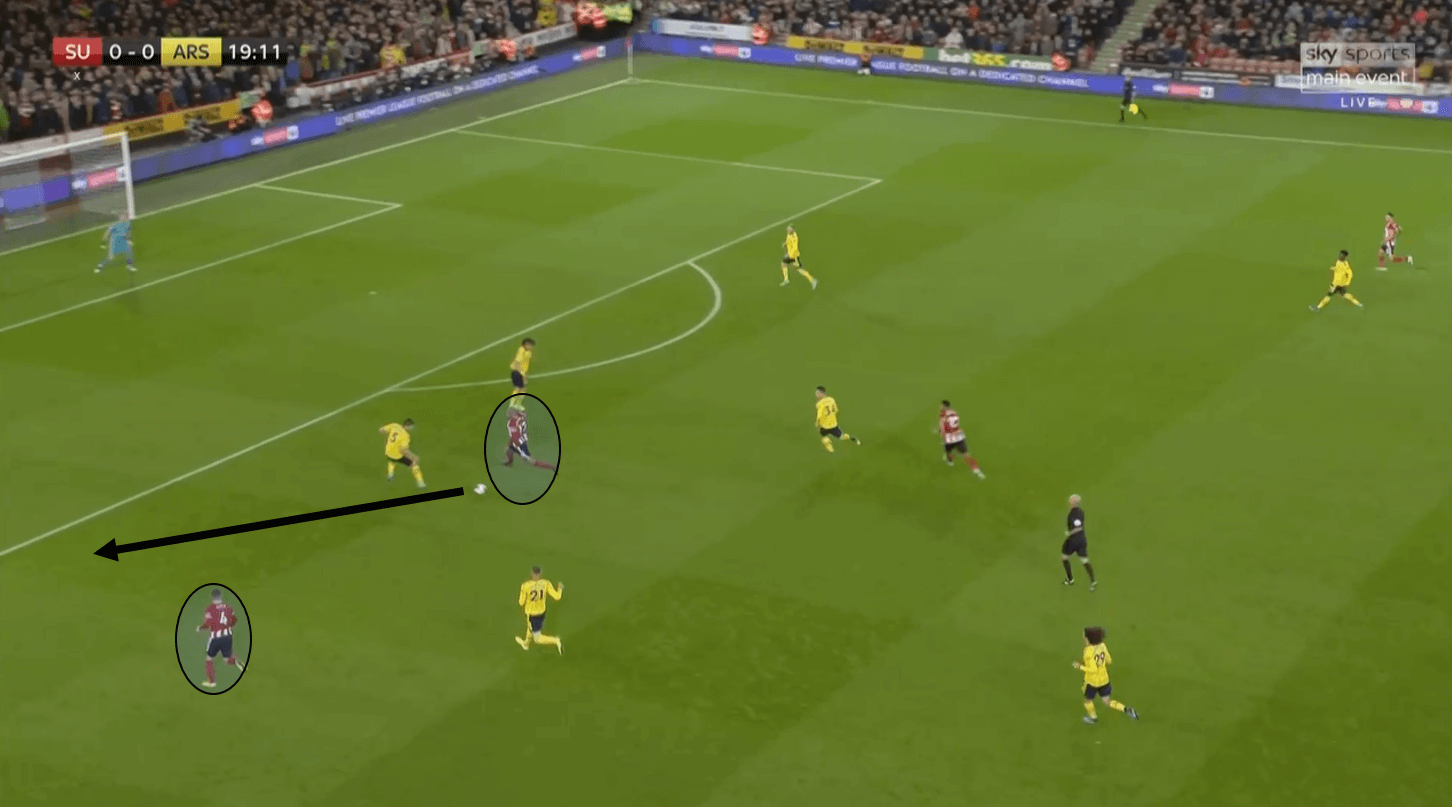
Fleck gets off a cross, but his pass is intercepted by Luiz. Luiz clears the ball upfield. This initial attack had urgency and numerical superiority down the left side. Sheffield United intentionally drew out Chambers and Geundouzi and then attacked the space behind them.
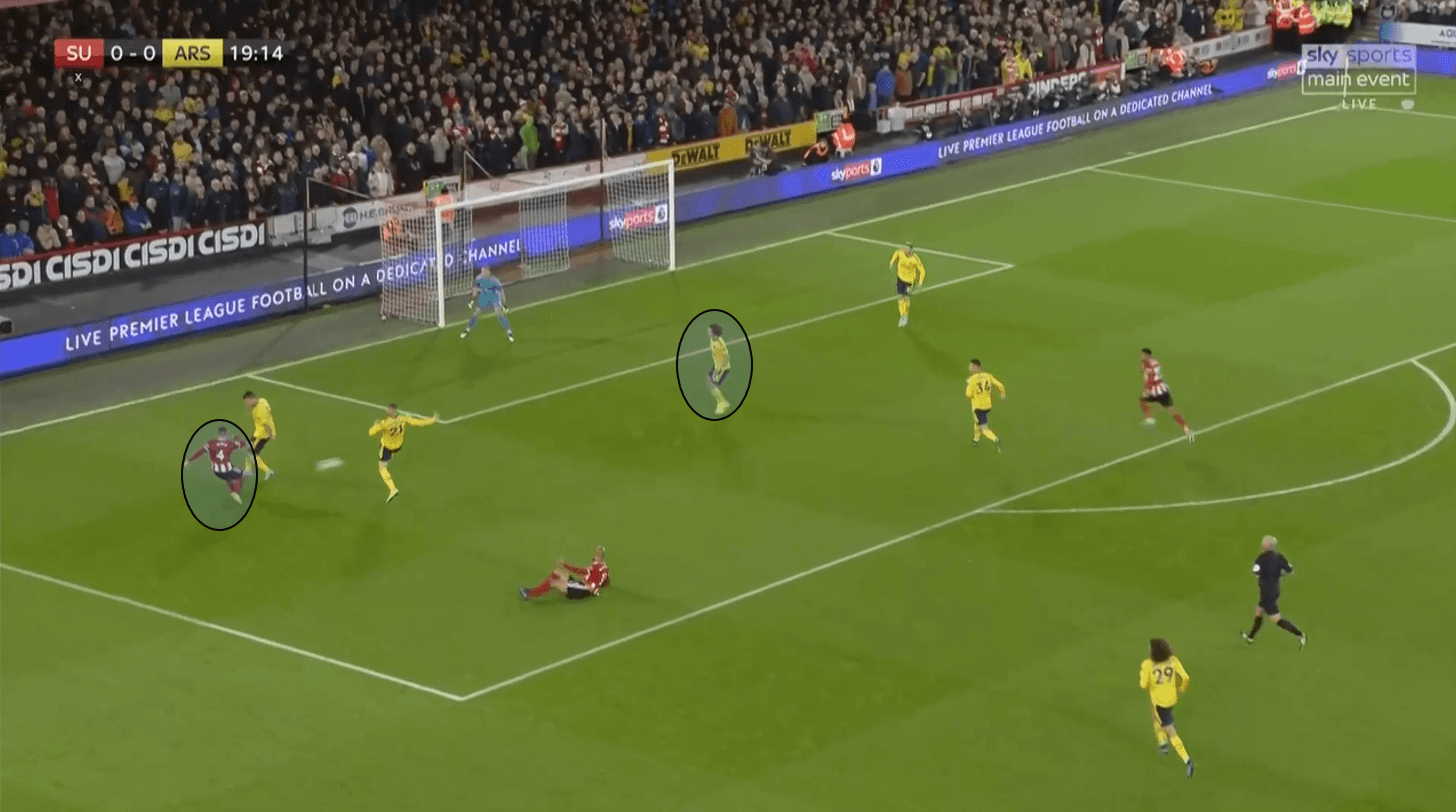
Sustained Attack Down the Left
The Luiz clearance does not end the attack. Sheffield United go with urgency directly at the left side again. The clearance goes to Sheffield United captain Oliver Norwood who heads it down to Stevens and Sheffield United go again down the left.
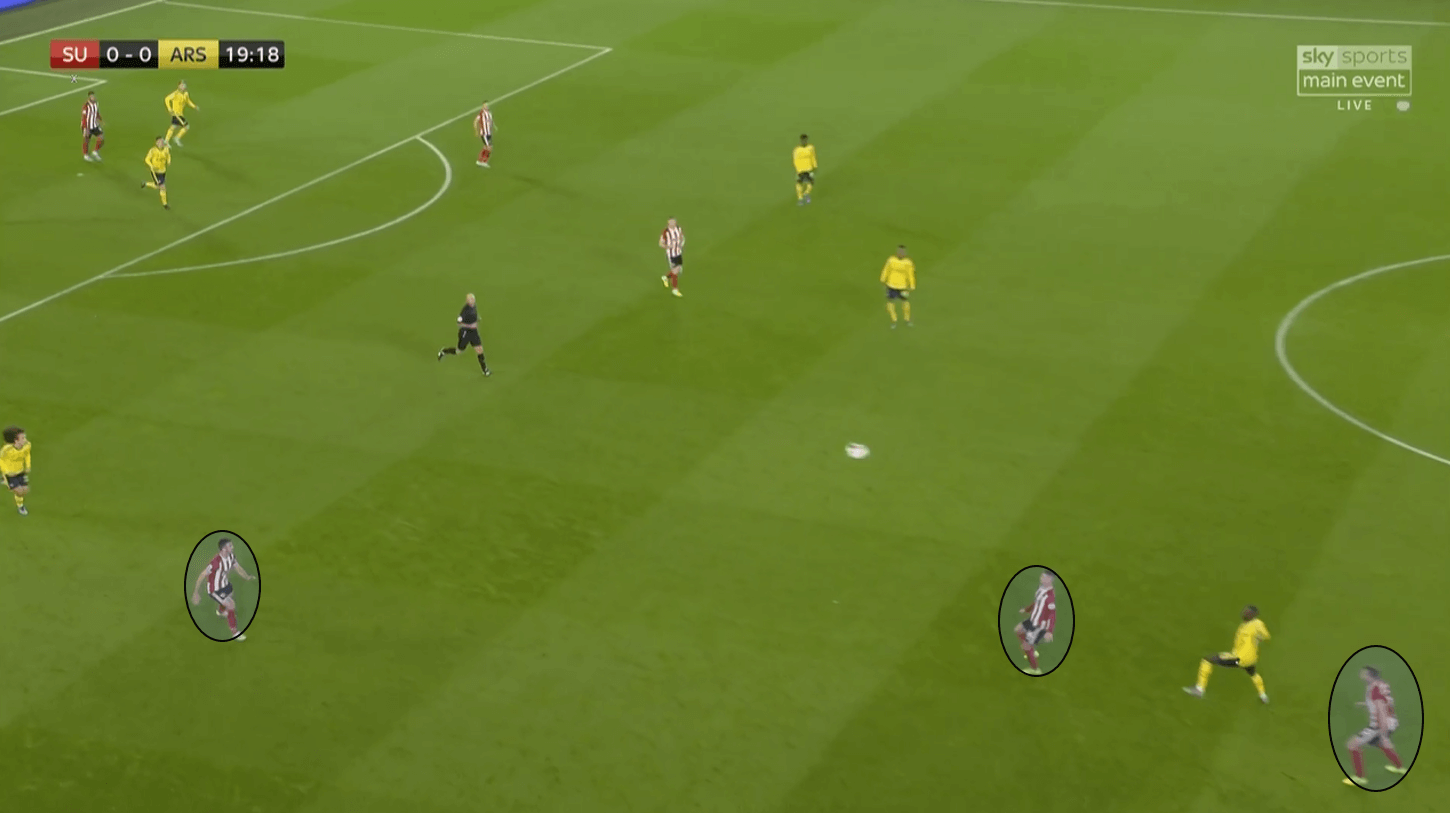
Stevens collects the ball and the centre back O’Connell bombs forward on the underlap. Sheffield United pulls out all the stops to get Arsenal down the left.
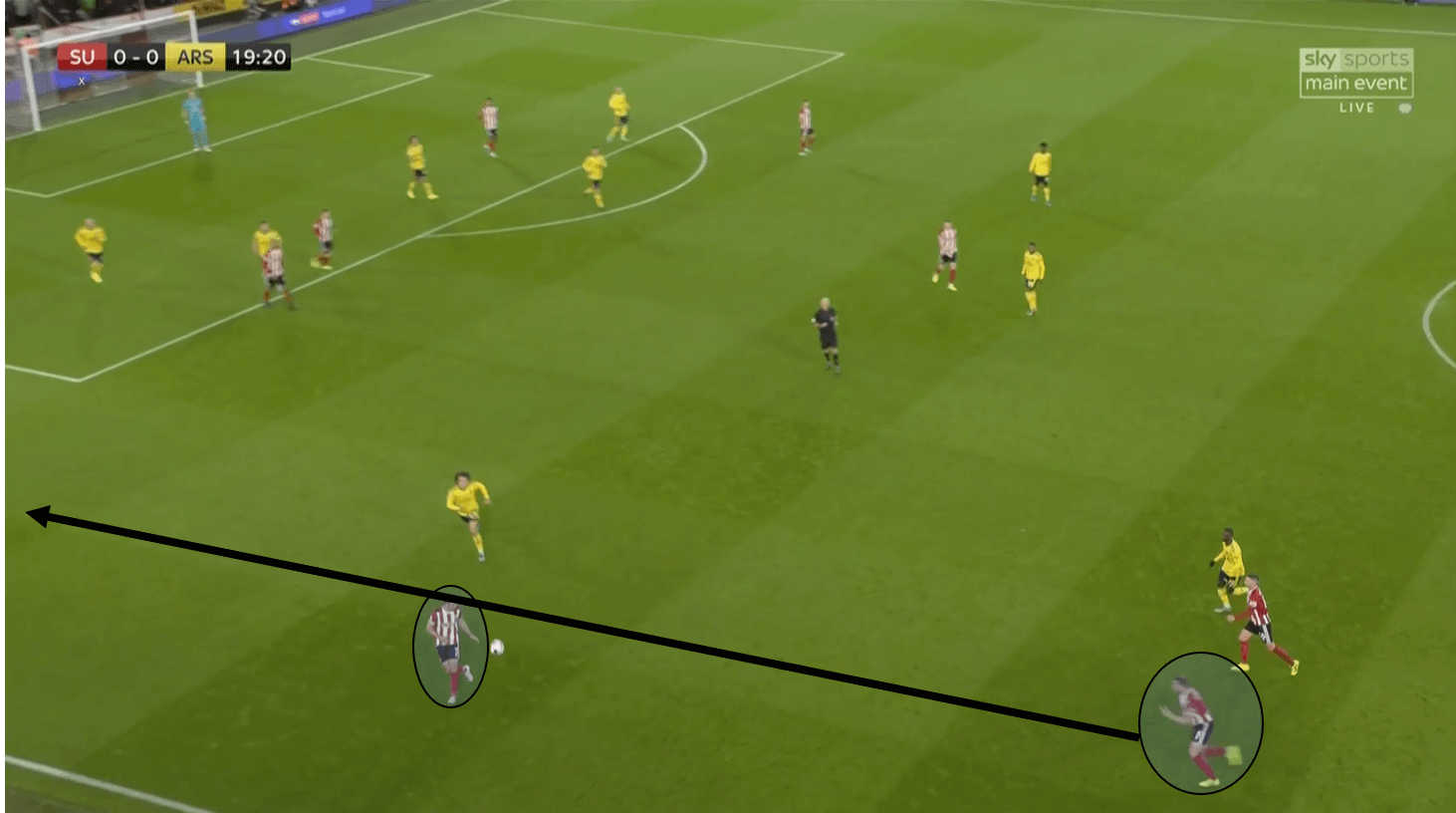
Geundouzi is drawn out by Stevens. The centre back O’Connell is up high on the left sideline. You can only see his foot in the image below. Stevens passes around Geundouzi creating a four vs two on the left side of the pitch.
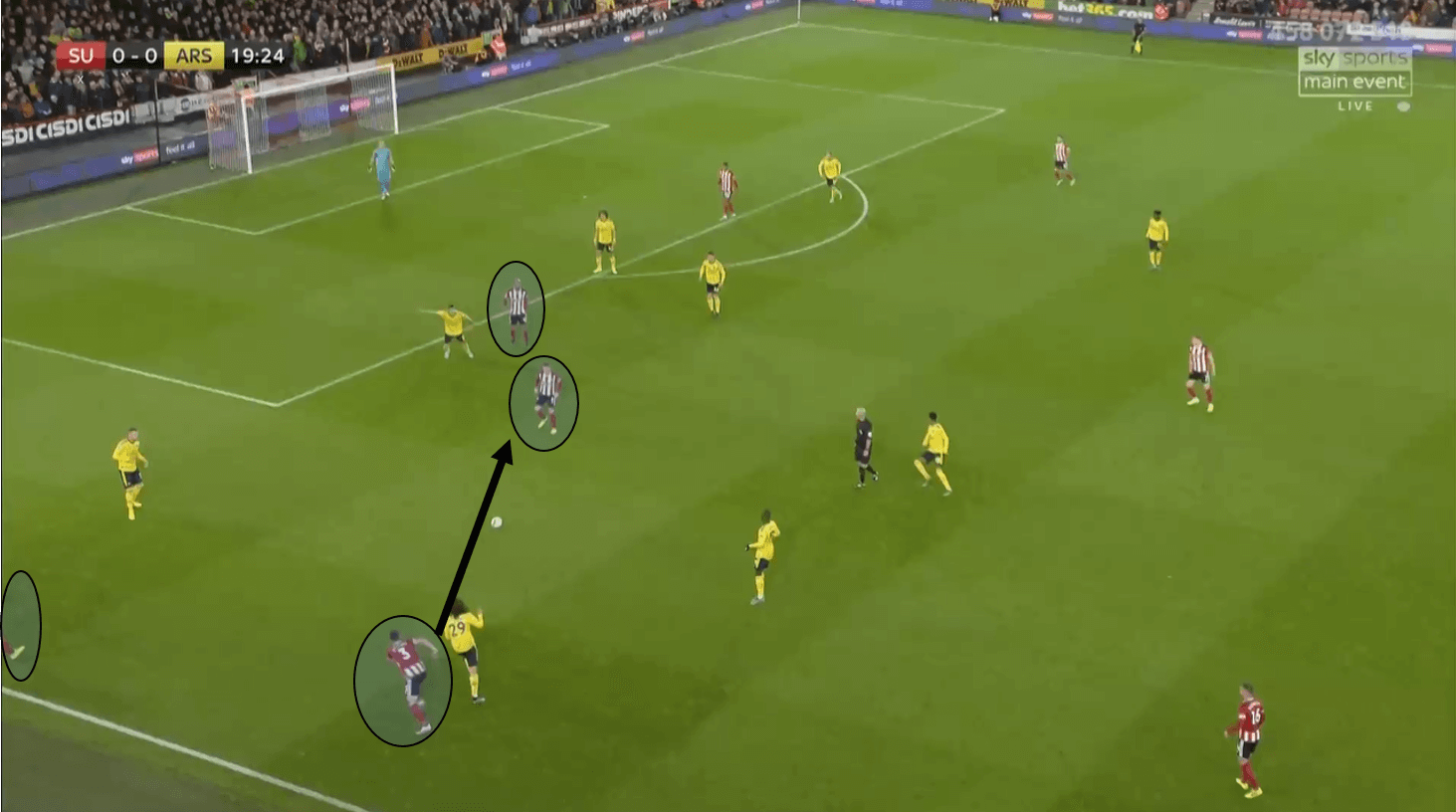
The result of the sustained attack is a ball into the box with two runners queued up on the backside.
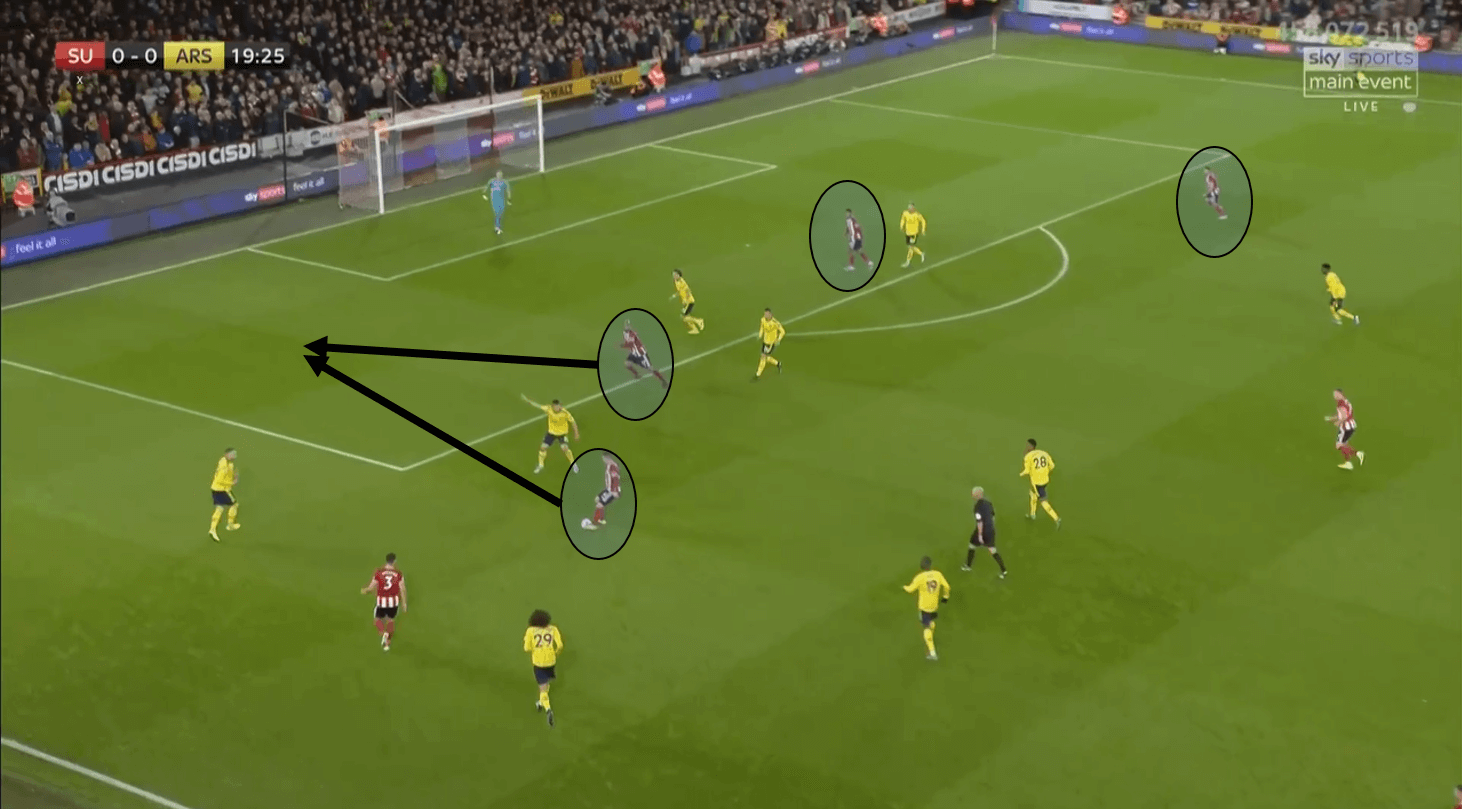
Chris Wilder clearly had the intention of drawing Chambers and Guendouzi out and gaining numerical superiority down the left. The next image shows the attacking positioning of the Sheffield United team via WhoScored.com. Sheffield United are attacking left to right in the graphic.
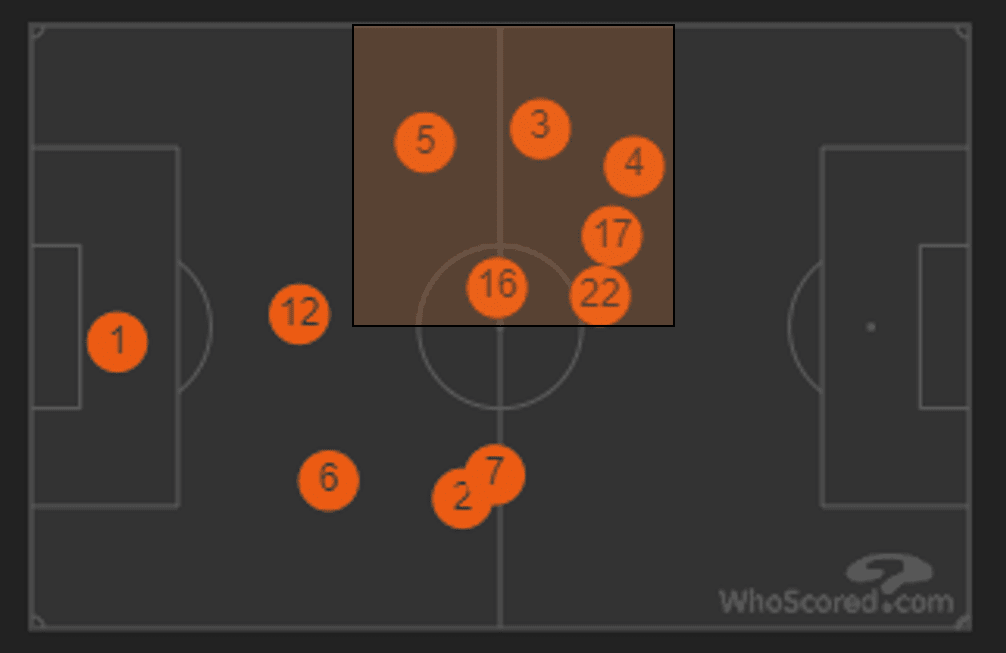
As shown above, Sheffield United focused six players to attack Guendouzi, Chambers, and Sokratis. They totally avoided the middle of the pitch and sparingly went down the right.
Exploiting Arsenal Defensive Corner Setup
The Sheffield United goal by Mousset came through fantastic exploitation of the Arsenal defending corner tactic. The setup defensively for Arsenal is shown below. Aubameyang, Xhaka, and Luiz are free defenders angled from the front post to the six. The rest are man-marking.
Sheffield United exploits this setup by putting Mousset on the goalkeeper and three aerial threats back post. John Eagan makes a hard run to the near post to occupy Aubameyang and Xhaka.
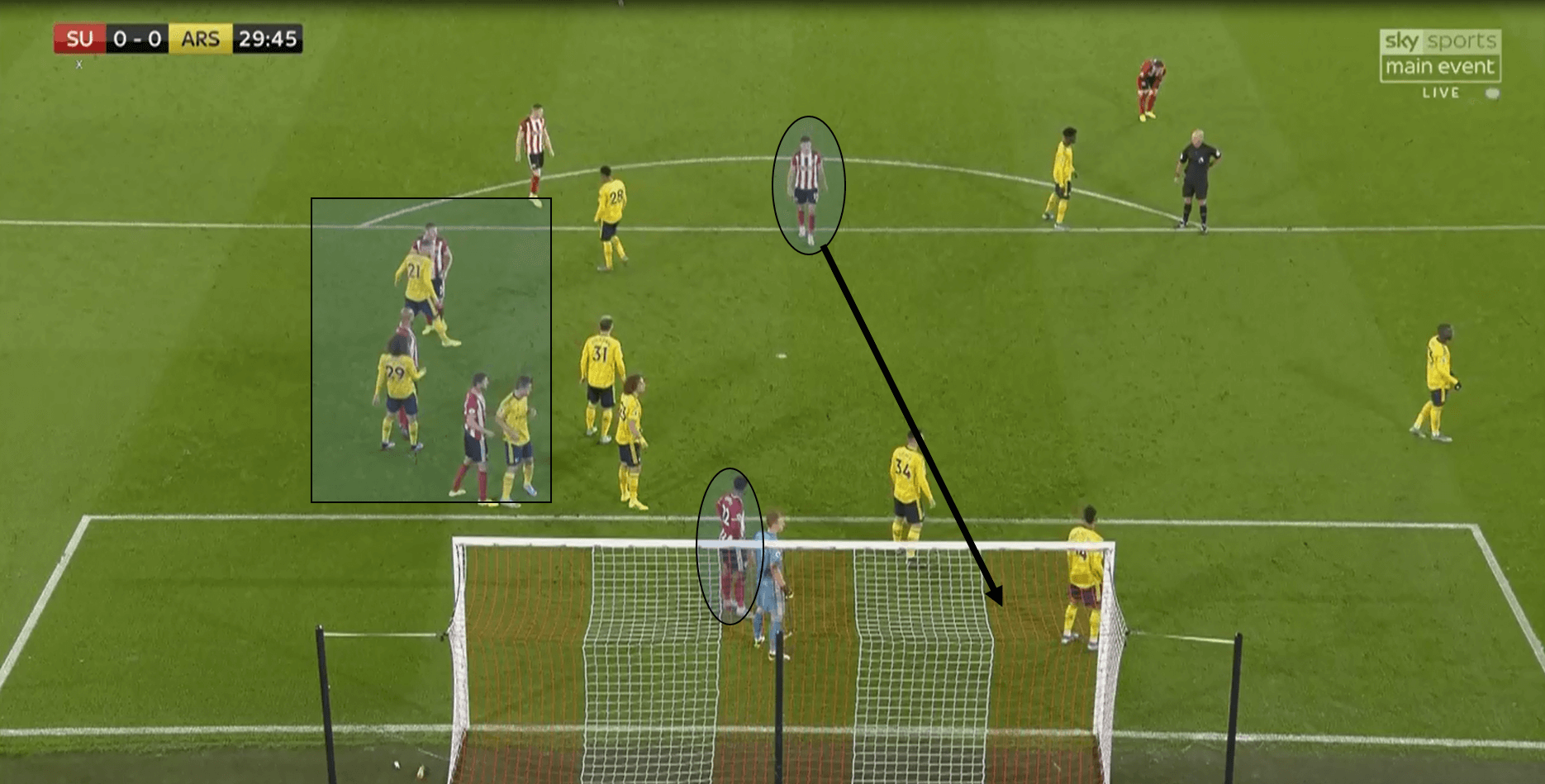
The service is to the back post and won by Jack O’Connell. Eagan’s run has kept Xhaka away from Mousset.
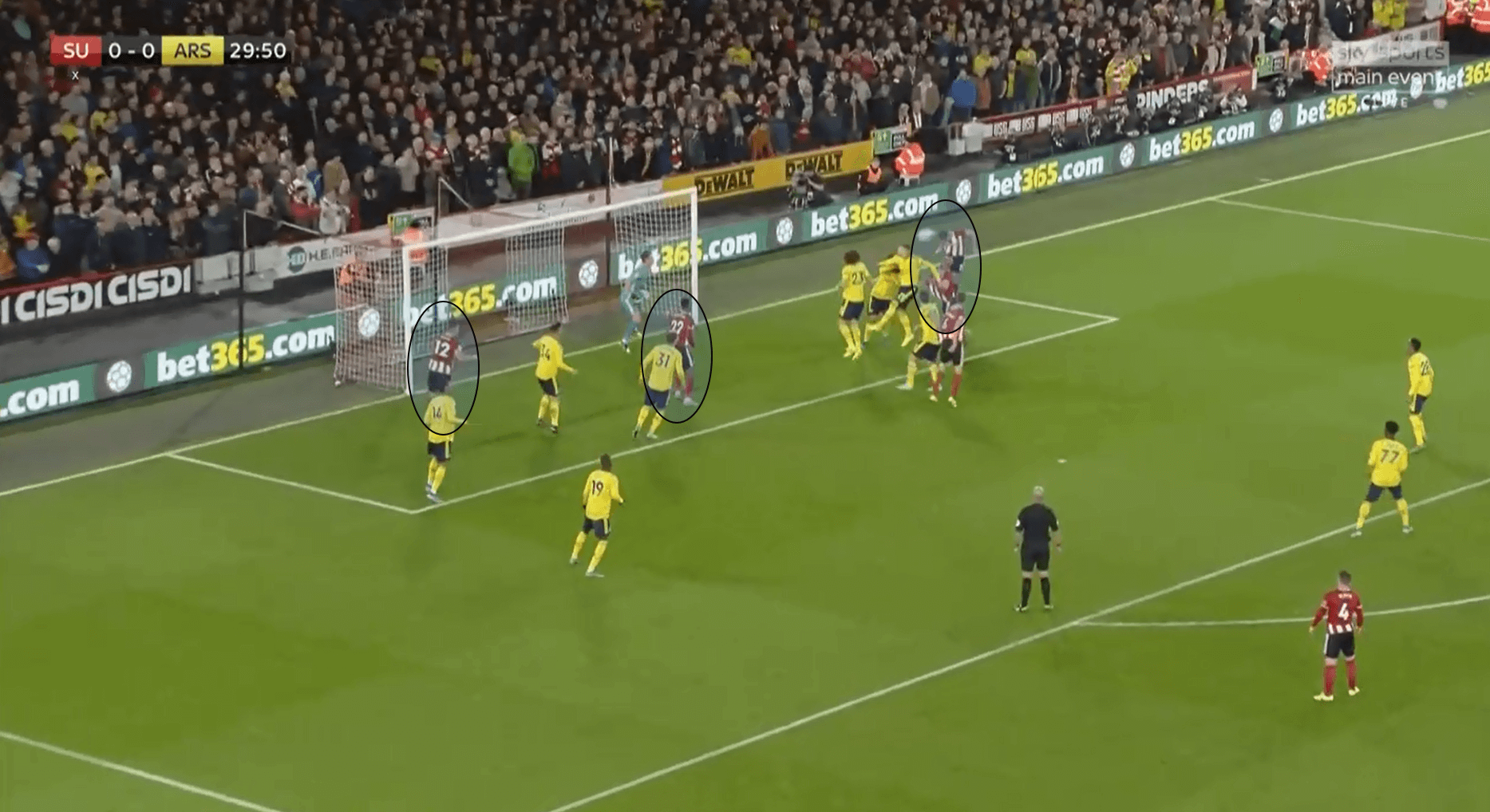
Sheffield United has cleared the entire centre of the six of Arsenal defenders. The O’Connell knockdown goes straight to Mousset for the tap in goal.
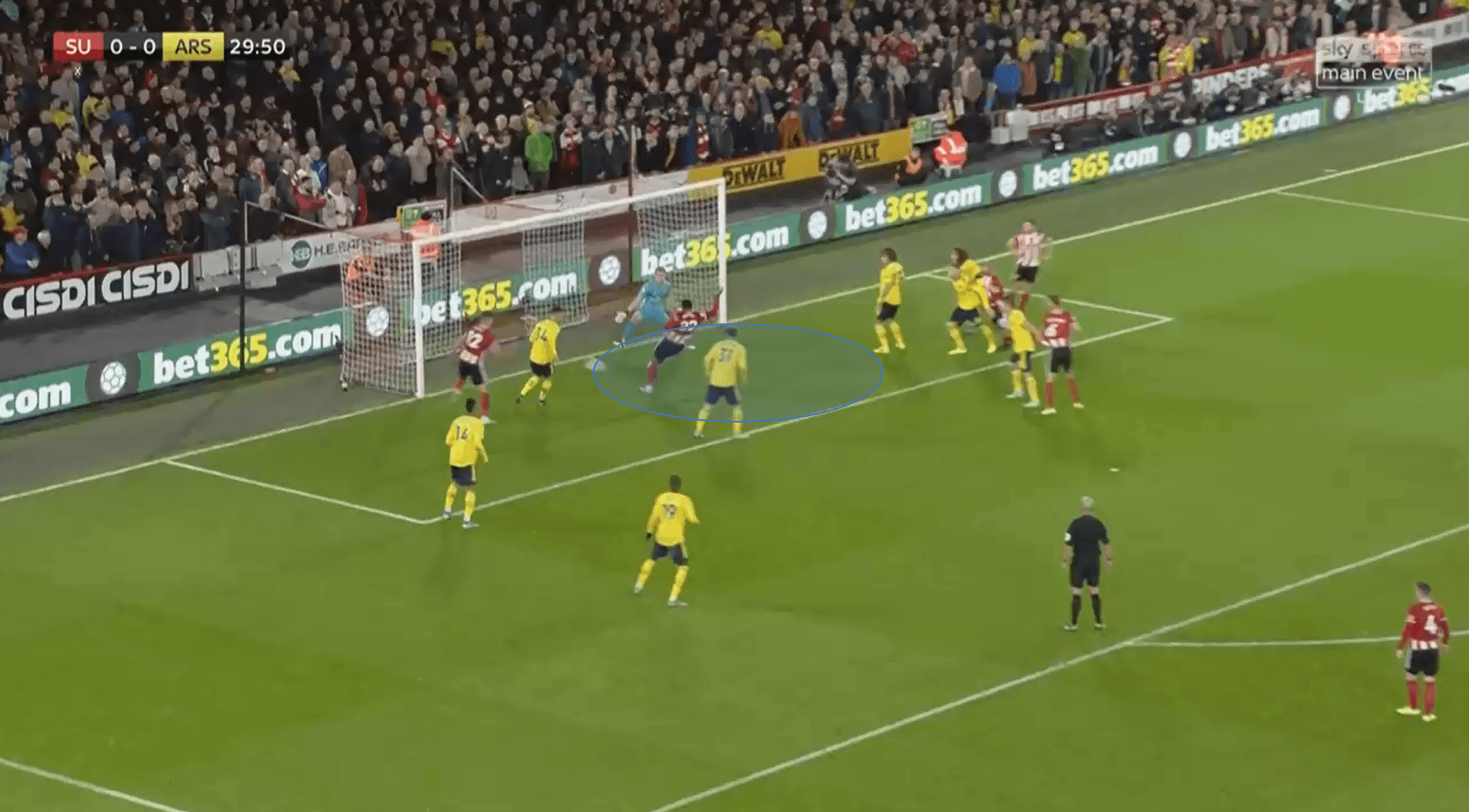
Shockingly, Arsenal sets up the exact same way defending a corner in the 87th minute. There was no tactical adjustment by Emery so Sheffield United go again with the same tactic. Billy Sharp in front of goal, Eagan making the run from deep to occupy the Arsenal front post defenders, and three targets back post.
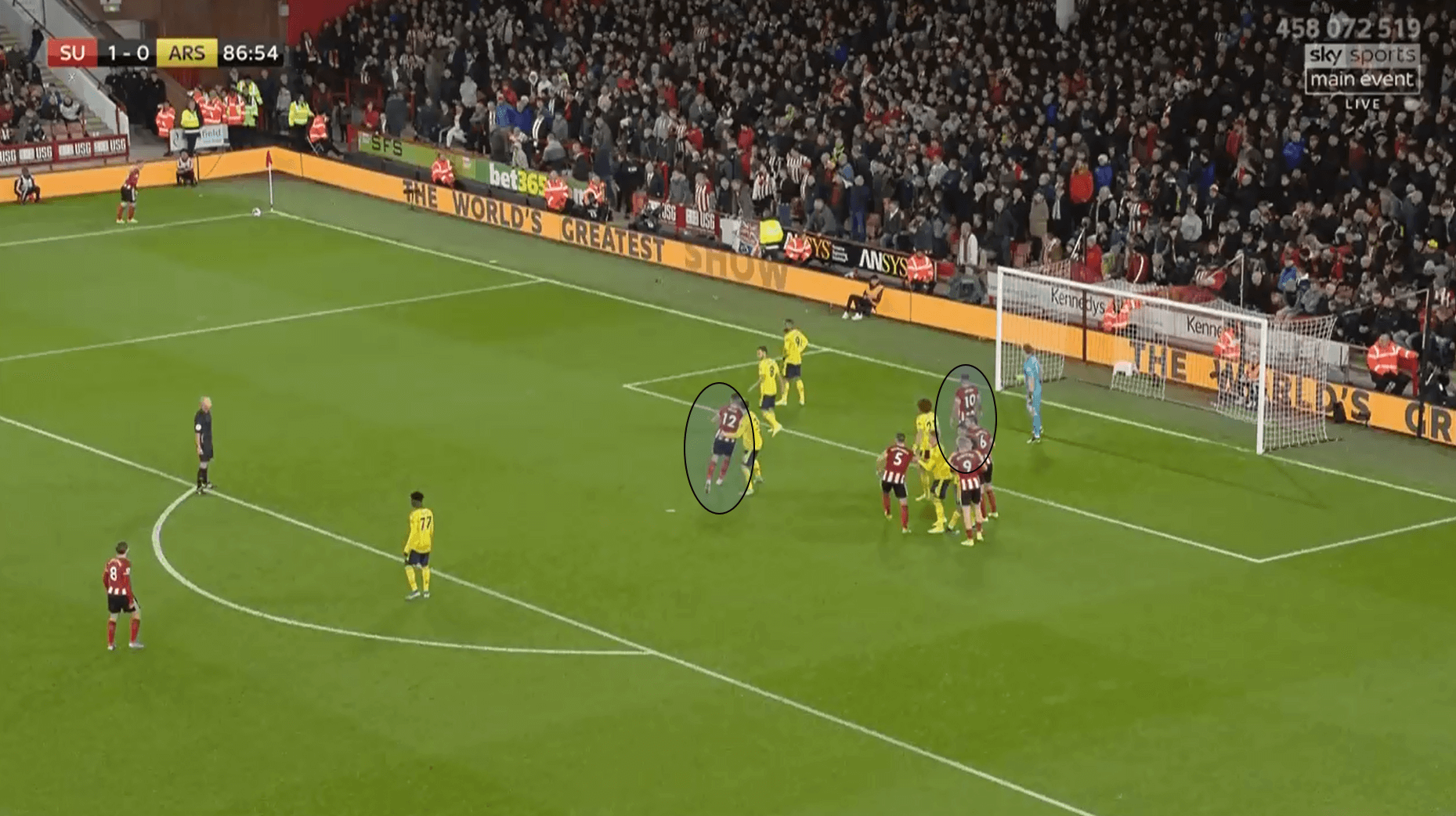
Fortunately for Arsenal, the service does not get back post for the knockdown to Sharp. The cross in goes into the middle for McBurnie who misses the goal. It is surprising how Arsenal allowed the exact same tactical exploitation.
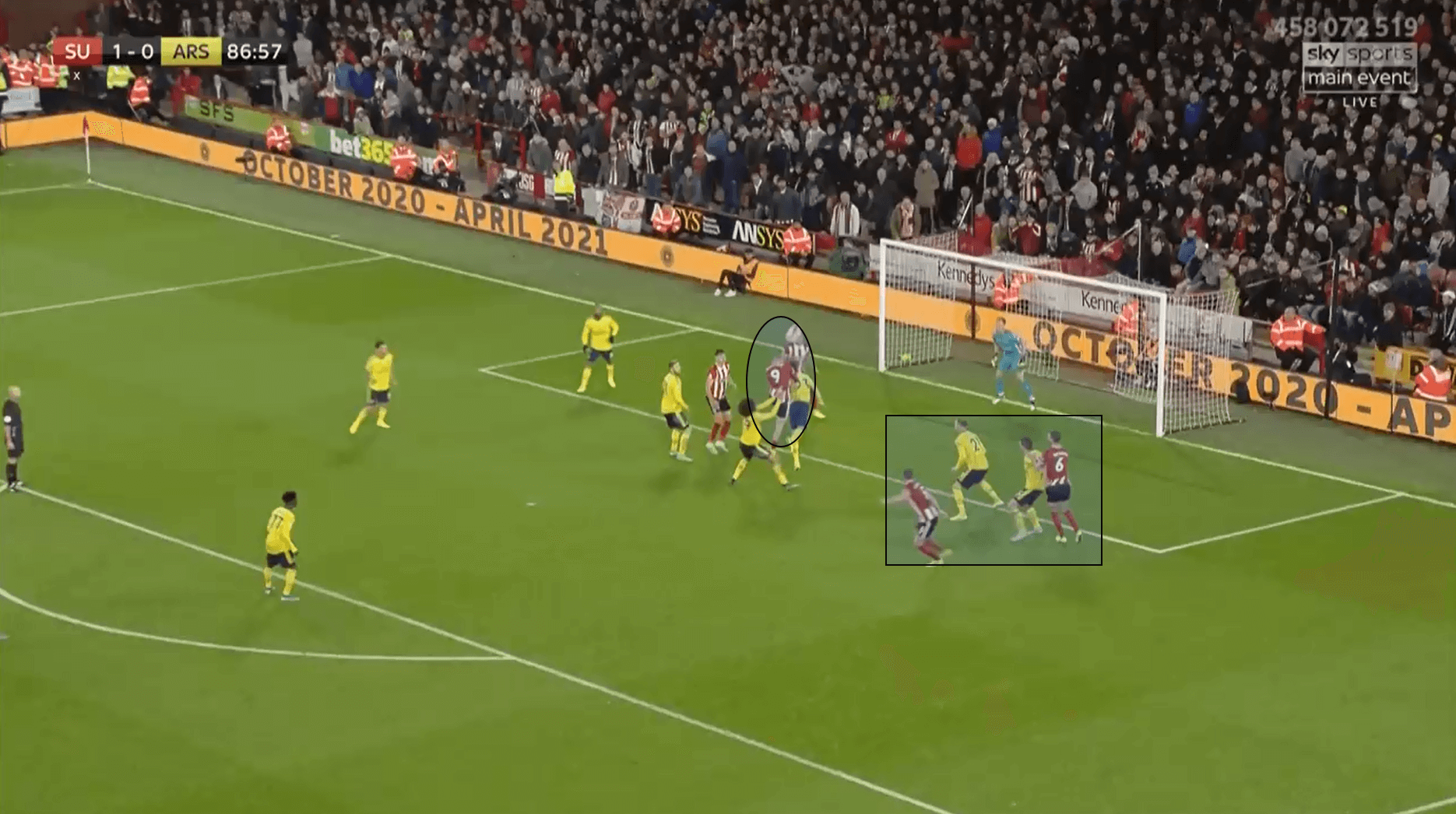
Arsenal Possession Non-Dominant Dominance
Arsenal statistically dominated the possession percentage. They had 61% of the ball in the 1st half and 77% in the 2nd half. Arsenal had clear domination of the ball. Despite the statistical advantage, they had no advantage in shots, xG, or the scoreboard. In fact, their only “big chance” of the match came off of a counter-attack in the 1st half. Their possession superiority gave them little advantage.
The reason for the lack of advantage can be seen in the passing statistics. According to WyScout, Arsenal had 603 total passes. Of those passes, only 173 were forward passes. 71% of Arsenal passes were backward or sideways. Arsenal completed forward passes accounted for 25% of their completed passes. Only 1 of 4 completed passes was a forward pass for Arsenal.
Arsenal suffered from a lack of tempo and a lack of urgency in attack. Once Sheffield United got the goal, Arsenal struggled to break down the well-drilled Chris Wilder defence. The slow passing build-ups and lack of runs in behind meant that Arsenal could not move the defence out of shape.
The sequence from Arsenal that best reflects the lack of urgency and tempo was a potential counter in the 2nd half. The image below shows Dani Ceballos playing a long pass into Aubameyang on the sideline.
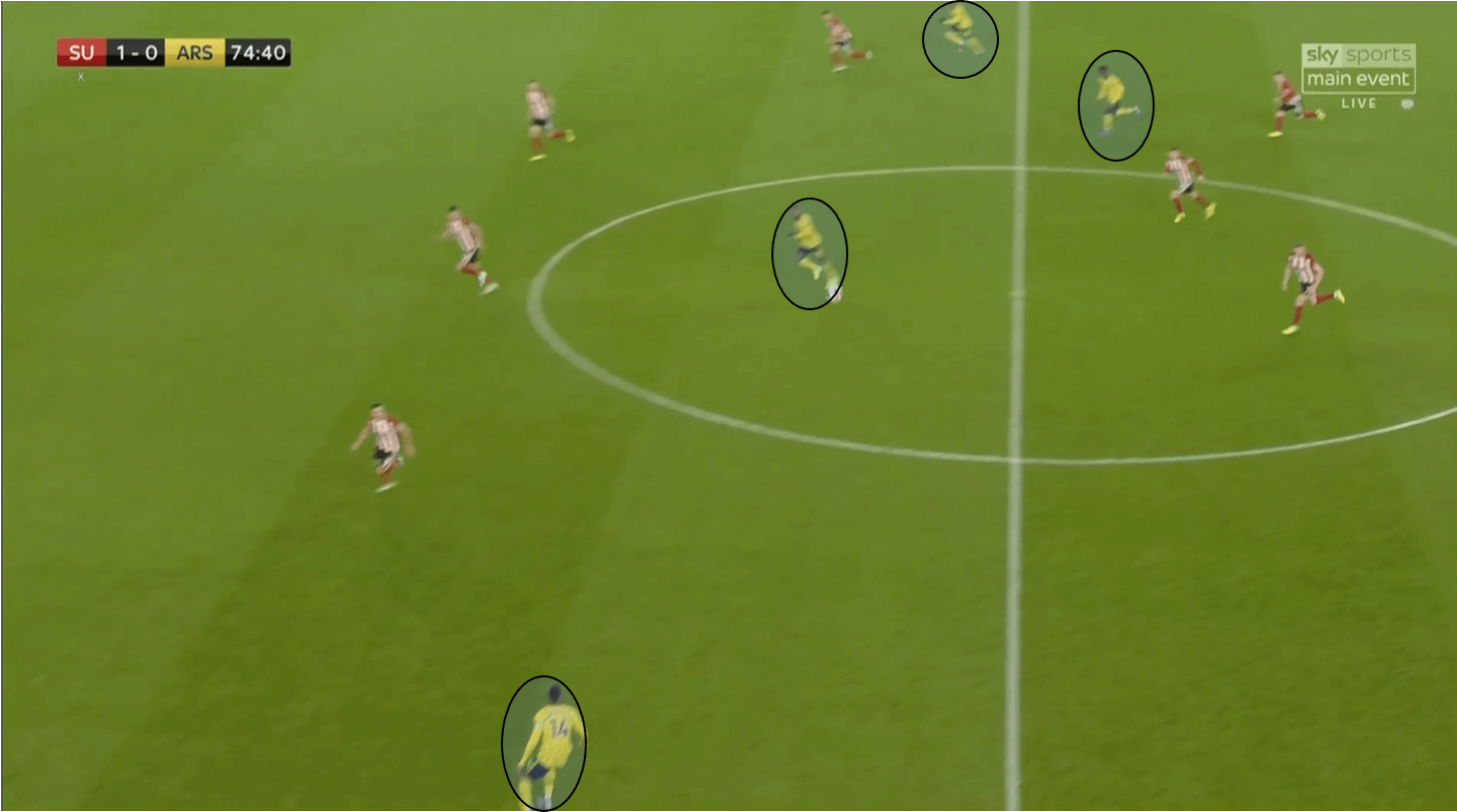
Aubameyang receives the ball and has the opportunity to create a four vs four attack. Instead of attacking with urgency and exploiting the space available, he dribbles into pressure.
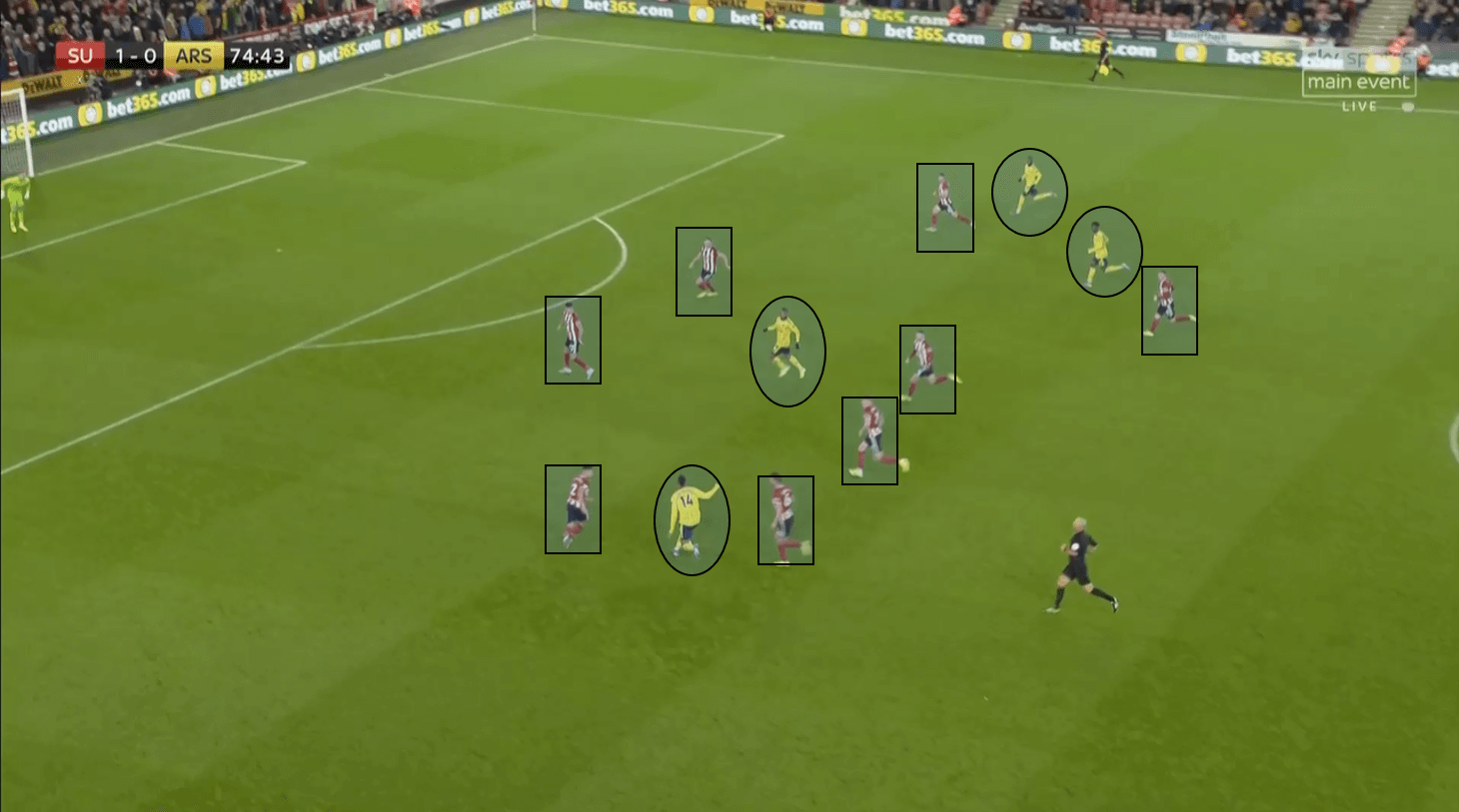
Aubameyang compresses the field and allows Sheffield United to get back. The potential four vs four is converted to a four vs eight. Eight players for Sheffield United get behind the ball and more damning is no other Arsenal player gets across midfield!
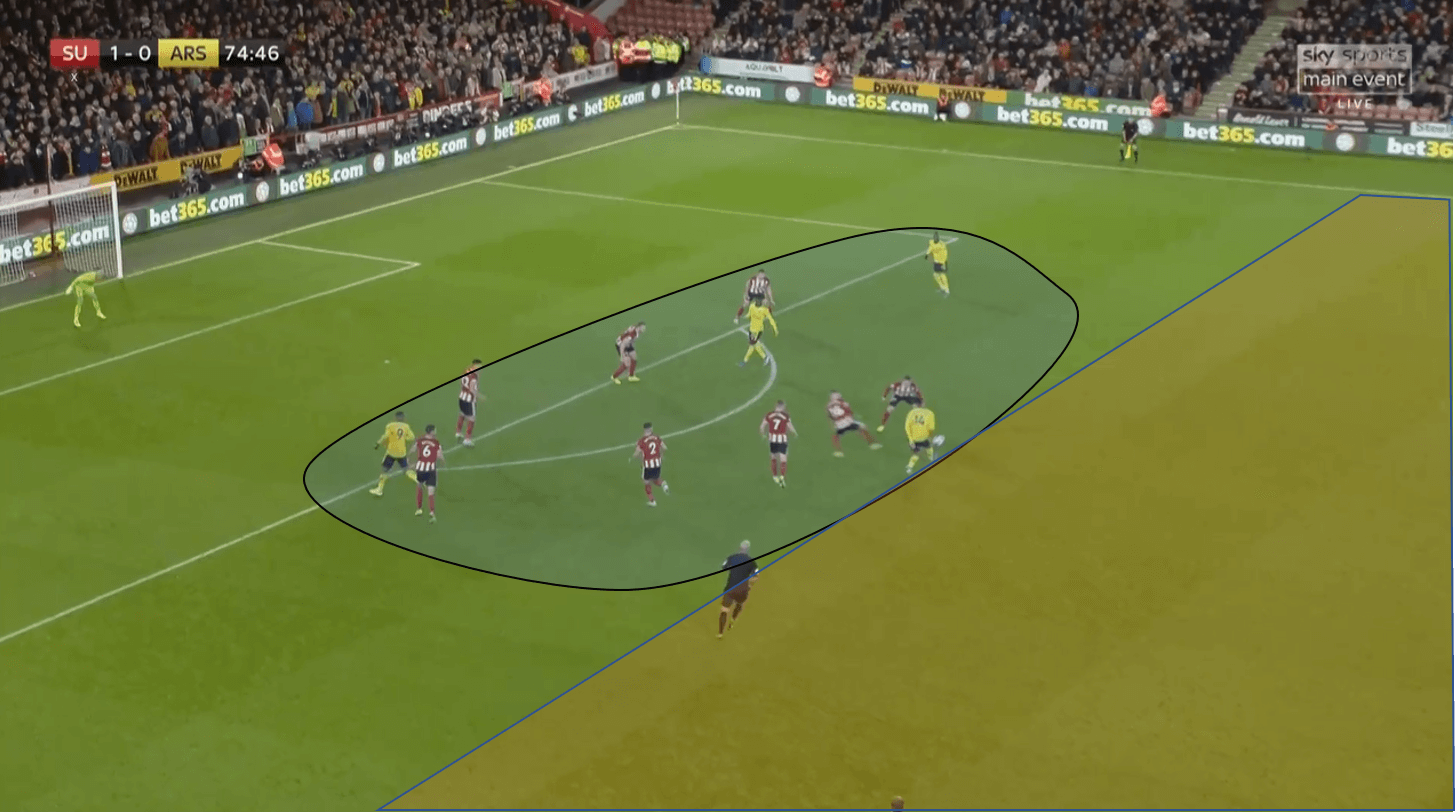
The above sequence was the norm for Arsenal. They let Sheffield United get their defence set and then they passed sideways, sideways, sideways, sideways. They rarely drew Sheffield United out with movement off the ball or urgency to get numerical advantages.
Conclusion
The tactical battle was a clear victory for Chris Wilder. He set out to exploit the left side of the pitch. The exploitation did not get them a goal in the run of play, but it secured them seven crucial corners and five shots from inside the box. Secondly, Wilder expertly and intentionally exploited the Arsenal corner defence. The lack of urgency and purpose of possession for Arsenal sealed the Sheffield United victory.
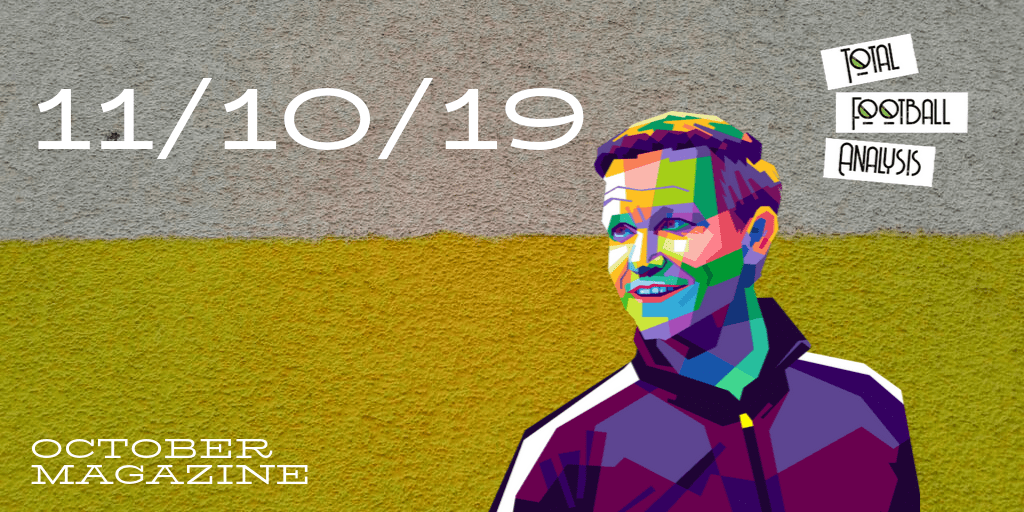
If you love tactical analysis, then you’ll love the digital magazines from totalfootballanalysis.com – a guaranteed 100+ pages of pure tactical analysis covering topics from the Premier League, Serie A, La Liga, Bundesliga and many, many more. Buy your copy of the October issue for just ₤4.99 here





Comments